Abstract
The authors discuss in this paper the potential of two power plant concepts for distributed generation, based on the integration of a cogenerating micro gas turbine with a solar panel array. The first one relies on the adoption of a parabolic trough network with an intermediate thermal carrier, while the second one considers the direct heating of the working air in a solar tower system. The first solution also includes a bottoming organic Rankine cycle (ORC) plant, so that it is mainly addressed to the power output increase. The second one involves a relevant temperature increase of the air entering the combustor, so allowing a direct fuel energy saving, whose amount is strongly variable with both the solar irradiance and the eventual part-load operation. In addition, the latter solar-assisted scheme involves noticeable variations in the conditions for the combustion development. This suggested the authors to proceed with a detailed CFD analysis of the combustion, after a preliminary thermal cycle study for highlighting the main benefits from the solar integration of the power plant.
1. Introduction
The need to find a balance between the worldwide demand for electricity and the foreseeable depletion of fossil fuel, together with the effects of thermo-chemical pollution, is soliciting the research in the field of alternative energy sources. Particularly, in regions with high solar energy resources, solar power plants represent an attractive alternative solution.
Solar thermal energy can play different roles in power generation and its combination with the conventional fossil-fuelled plants could reduce pollutant emissions and fuel costs [1,2,3,4,5,6,7,8,9]. Many authors have been involved in this research area, showing a renewed and growing interest in power plants operating with organic Rankine cycles, particularly the small-scale applications [10,11,12]. Others have studied hybrid systems with parabolic dish or solar tower. In [13] the authors present a technical and economic analysis by using a thermodynamic model of a hybrid energy system comprising a parabolic dish solar energy concentrator and a micro gas turbine. The results indicate that moderate supplementary firing is interesting for it increases the average efficiency of the system and the annual yield. In [14] an innovative methodology to perform market analysis of a new solar power generation technology based on parabolic dish and micro gas turbine engines is described. Zare [15] proposed a novel combined cycle for power generation from solar power towers. The system consists of a closed Brayton cycle and two organic Rankine cycles which are employed to recover the waste heat of the Brayton cycle. Results show that a recuperative plant working in hybrid mode has a fair potential to generate a stable power output with reduced fuel consumption and reduced greenhouse emissions. In [16] a HSGTPP (Hybrid solar gas turbine power plant) is considered with a solar heliostat field and a tower. The analysis has been made with and without the storage system. Santos and others [17] developed an entirely thermodynamic model for predicting the performance records of a solar hybrid gas turbine power plant with variable irradiance and ambient temperature conditions. A high-temperature high-concentration pressurized-air solar receiver is considered in [18] for driving a power generation Brayton cycle.
In some recent papers [19,20,21,22,23], the authors have introduced and discussed their proposals concerning the integration of a micro gas turbine (MGT) with concentrated solar power systems. Basically, two different plant layouts have been examined:
- The first one [19,20,21] makes use of solar array with parabolic troughs and diathermic oil as an intermediate heat medium. An air preheating upstream of the conventional MGT recuperator is so allowed and, consequently, an increase in the exhaust temperature is induced. The main advantages from this solution result in an improved availability of recoverable heat. Therefore, it appears to be particularly suitable for the matching with a bottoming ORC device and for combined heat and power applications as well.
- The second proposal [22] founds on the adoption of a central tower with a mirror based solar array and a direct air heating downstream of the MGT recuperator. As it is self-evident, in this case a more significant enhancement of the MGT efficiency is expected but, on the other hand, a more expensive and technically challenging plant layout must be set up. A preliminary examination of the power plant response under varying environmental and load conditions has put into evidence a satisfactory off-design behaviour.
In both cases, the authors’ methodology is not limited to a simple thermodynamic analysis but it proceeds with the CFD analysis of some key components: in particular, the combustion process is carefully simulated in order to highlight the most significant differences that take place as a consequence of changes in the combustor operating conditions. Furthermore, both power plant layouts are worthy of an optimization in terms of solar field extent, in order to lead to the best compromise between energy savings and additional investment costs.
This paper goes deep into the comparison of the possible solar-assisted plant layouts by means of a mixed thermodynamic—CFD approach that takes into account the matching of the rotating components. The purpose is a thorough analysis of the plant response under varying conditions during daily and yearly periods. In particular, the computational process consists of a thermal cycle analysis task, which addresses the evaluation of the main performance parameters, followed by the reacting flow calculation. The latter employs boundary conditions transferred by the previous step and provides detailed information on both combustion efficiency and pollutant formation.
The results refer to a 30 kW micro gas turbine fuelled with either fossil fuels or biogases. The differences between the two layouts are examined both in terms of fuel energy saving and environmental impact.
2. The Integrated Power Plant Concepts
Like stated before, two different concepts have been examined for the integration between the micro gas turbine and a solar field and they are briefly recalled in the following. Both solutions rely on the use of a 30 kW micro gas turbine, whose reference data are provided in Table 1.

Table 1.
C30 micro gas turbine datasheet.
2.1. Solar Array with Parabolic Collectors and MGT-ORC Combined Power Plant
In this case (Figure 1), solar contribution consists of a thermal energy supply from the parabolic troughs to the air exiting the compressor of the micro-gas turbine. In this way, the air temperature at the recuperator inlet increases (point 2s in Figure 1) and this induces a temperature rise for the exhausts at the hot side outlet and, therefore, at the ORC boiler inlet.
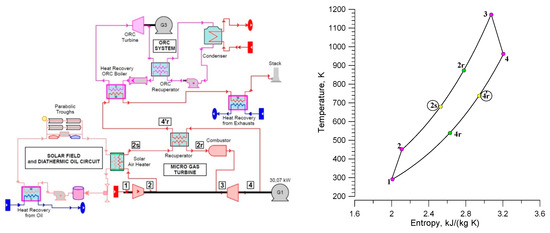
Figure 1.
Layout and thermal cycle of the combined MGT-ORC power plant with the solar array integration.
Consequently, an increased amount of recoverable heat is expected at the MGT discharge, which is partly or totally transferred to the bottoming ORC system for conversion into additional mechanical power.
The potential of this solution is strictly dependent on the temperature limits of the organic working fluid and on the ORC expander as well. This aspect has been carefully analyzed in previous authors’ papers [19,20,21] by comparing solutions with R245fa, R134a and ammonia. The most efficient conditions in terms of power output and energy saving were obtained with the R134a organic fluid and, therefore, only this one has been considered in this work. The operating data of the ORC bottoming plant are reported in Table 2.

Table 2.
Data of the ORC bottoming plant.
The setup of the combined plant calculations made use of the operating data of the Capstone C30 micro turbine, whose main features are recalled in Table 1. Regarding to the solar array, the reference direct irradiance was estimated for a 40.1° latitude site at 12:00 of the vernal equinox, so obtaining peak and daily values of 609.4 W/m2 and 7029 kWh/m2. Parabolic trough collectors were considered and the heat transfer medium was the DOWTHERM A oil, with a maximum temperature of 427.65 °C.
The plant layout in Figure 1 is completed by two heat recoveries from both the diathermic oil and the exhausts. Such a solution allows combined heat and power (CHP) operation and, at the same time, good flexibility in terms of plant response to variable heat and electricity demands.
2.2. Integration of the MGT with a Solar Tower
This second concept (Figure 2) considers the presence of a solar array along the air flow path after the recuperator. Such a solution founds, of course, to the achievement of higher temperature levels for the air leaving the solar path, so that an enhanced solar power concentration is needed through a reflecting mirror array. Some examples may be found in both technical literature and in practical applications, but they often make use of externally fired gas turbine. Conversely, the present proposal keeps the internal combustion arrangement and therefore the combustor response must be carefully investigated. The point 2s is, in this case, located downstream of the recuperator and a considerable increase in the combustor entry temperature is expected.
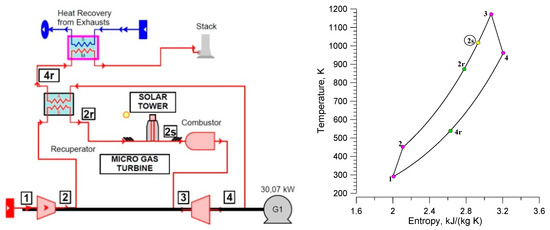
Figure 2.
Layout and thermal cycle of MGT power plant with the solar tower integration.
In a previous work [22] the authors have demonstrated that the plant response is directly affected not only by the daily and yearly variations in solar irradiance but, mainly, by the plant load level. As a matter of fact, part load conditions usually imply a reduction in the firing temperature and this induces an efficiency decrease in fully fired gas turbines. On the contrary, this hybrid solution allows enhancement of the solar contribution specially when reducing the turbine power output. Actually, the variable speed operation causes decrease in both air flow rate and pressure ratio. Consequently, some significant changes take place in the thermal cycle. A comparison between the Brayton cycles at full load and part load (continuous and dashed lines, respectively) is given in Figure 3:
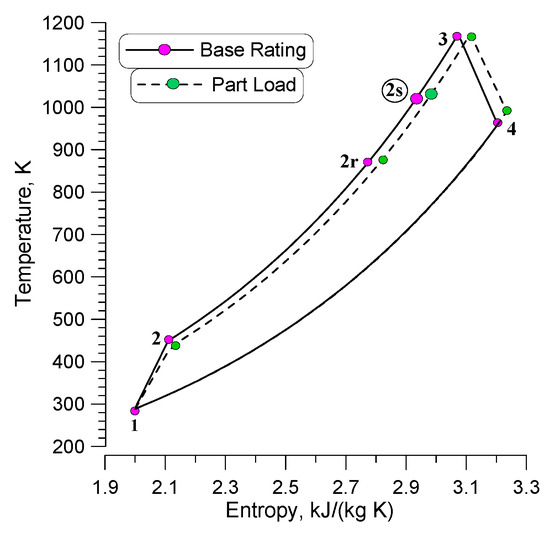
Figure 3.
Comparison between different solar-assisted Brayton cycles (layout in Figure 2) at base rating and part load.
- The reduced pressure ratio leads to higher temperatures at the turbine outlet.
- Consequently, the air temperature at the recuperator outlet is increased.
- The combined effect of the latter temperature and of the lower airflow rate induces higher temperature at the solar tower exit and this finally explains the reduction in the total heat supplied by solar source and fuel combustion.
3. Base Rating Operation of the Integrated Power Plant
3.1. Base Rating Data
A first estimation of the plant performance at the reference design point was obtained by means of the Thermoflex software simulator of the energy conversion systems described above. The computations are consistent with the plant layouts in Figure 1 and Figure 2 and they take into account the typical operating parameters that characterize the micro gas turbine at the design point, namely:
- A compressor polytropic efficiency of 0.78;
- A turbine polytropic efficiency of 0.80;
- A recuperator effectiveness of 0.85;
- Pressure losses through the recuperator and the additional heat exchangers of 3% through both cold and hot sides;
- Pressure losses of 4% through the combustor.
In addition, the changes in the compressor-turbine matching have been evaluated by introducing the operating maps (Figure 4 and Figure 5), in accordance with those suggested by reference [24]. This allows predicting variations in both mass flow rates and pressure ratios, by also considering the variable spool speed. In all cases the target value if turbine inlet temperature was set at 1173.15 K, according to the manufacturer’s data.
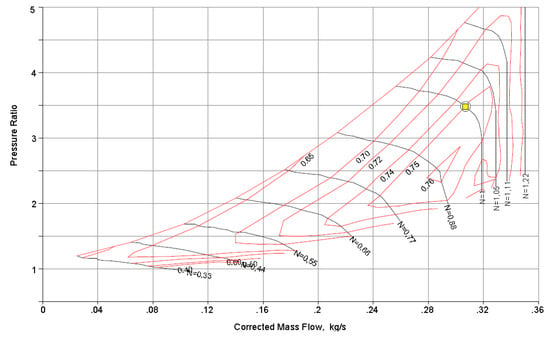
Figure 4.
Estimated C30 compressor maps.
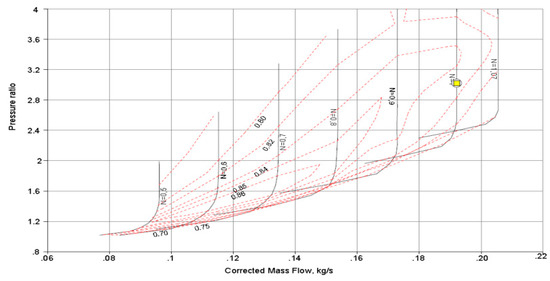
Figure 5.
Estimated C30 turbine map.
Table 3 reports the computed values of the temperatures at the characteristic points of the thermal cycles in Figure 1 and Figure 2, together with the pressure ratios and mass flow rates for each plant configuration. The plant performance referred to the layout in Figure 2 is also evaluated when considering a biogas obtained from an anaerobic digestion process [25,26], with a 62% of methane mole fraction and a 36% of carbon dioxide. This table also indicates that at base rating operation the air flow capacity of the compressor was slightly increased in order to establish a reference level of 30 kW net power output for a more immediate comparison with the different cases examined. Such a choice explains the air flow rate of 0.307 kg/s in Table 3, which is somewhat higher than the exhaust flow rate of 0.3 kg/s in Table 1.

Table 3.
Temperatures (K) and operating data.
Regarding to the solar irradiance, all results refer to the data at vernal equinox at noon at the Naples, Italy latitude. This choice is because at this date and time-hour a good compromise can be found between a lack and an excess in solar irradiance.
The same table highlights the main effect of the solar contribution:
- In the first plant layout, this effect consists of both an increase of the air temperature at the recuperator inlet and a higher exhaust temperature (points 2s and 4r, respectively. As already stated, this results in a larger heat availability for the bottoming ORC system and for thermal recovery.
- In the second one, the air enters the combustor at higher temperature levels so reducing the fuel amount that is needed for reaching the target firing temperature.
Consequently, Table 4 puts into evidence the major benefits that are obtainable from the two solar-assisted plant concepts. As expected, the main advantage from the first one is represented by an increase in the mechanical or electric power output. In particular, the power from the ORC system is enhanced because of the indirect contribution of the solar array. In addition, a non-negligible heat recovery is allowed from both the diathermic oil circuit and the exhausts leaving the ORC boiler. This allows an increase in thermal efficiency and preservation of an acceptable level of the fuel energy utilization factor as well. If referring to the total thermal energy supplied (i.e., solar + fuel) this solution exhibits an evident lack in effectiveness, so that its employment should be suggested only if the main objective is an increased power output or a fair flexibility with respects to the electric and thermal demands. Furthermore, the plant layout can be easily completed by thermal storage devices.

Table 4.
Performance data of the integrated solar-MGT-ORC CHP plant.
Conversely, the plant layout based on the solar power adoption leads to an immediate fuel energy saving that is confirmed by the better values of net efficiency and fuel heat rate in Table 4. Due to the additional pressure losses along the air flow path through the solar heat exchanger, a decrease in power output is, of course, observed. However, the energetic performance indices are much more favourable than in the first case. In particular, the fuel utilization factor appears to be higher than unit because of the concurrent effects of the fuel saving and the heat recovery from the exhaust.
Table 4 also reports the extent required for the solar array, in terms of reflecting area of the parabolic troughs and heliostat mirrors, respectively. The latter allows a concentration of solar power at higher temperature levels, and this explains the reduced total area, if compared to the one of the parabolic collector.
The benefits from the solar contributions may be also appreciated in terms of reduction of CO2 production and both solutions lead to a relevant decrease in this specific emission. In the case of the biogas fuelling, the CO2 emission includes the amount of carbon dioxide supplied with the gaseous fuel. Nevertheless, a reduction with respect to the base configuration is observed.
Basing on the above comparisons, the plant layout based on the integration for the MGT with a solar tower appears to be the more promising and this suggested the authors to proceed with an off-design analysis and to a more detailed study of the combustion process. Really, the air temperature increase at the combustor inlet produces significant changes in the fuel/air ratio and, more generally, in the combustion regime.
3.2. Part-Load Operation
As anticipated, the hybrid mode operation of the micro gas turbine integrated with the solar tower concept can also offer relevant advantages under part-load conditions. Actually, the electric generator set allows a variable speed of the turboshaft and the typical response of the micro turbine in a (rotational speed, power output) plane is shown in Figure 6. The operating domain is obtained by a matching analysis of the rotating and stationary components, which accounts for the compressor and turbine maps in Figure 4 and Figure 5. Consequently the operating region of the micro gas turbines is bounded by the typical limits of compressor stall and choked flow through both the turbomachines. Figure 6 refers to the base configuration in fuel only mode, but also in this case the variable speed allows a power output reduction in a wide range at constant turbine inlet temperature. Consequently, a moderate efficiency decrease is observed at part-loads, as highlighted by the related contours in Figure 7. In this figure, the iso-lines refer to the overall plant efficiency at generator terminals.
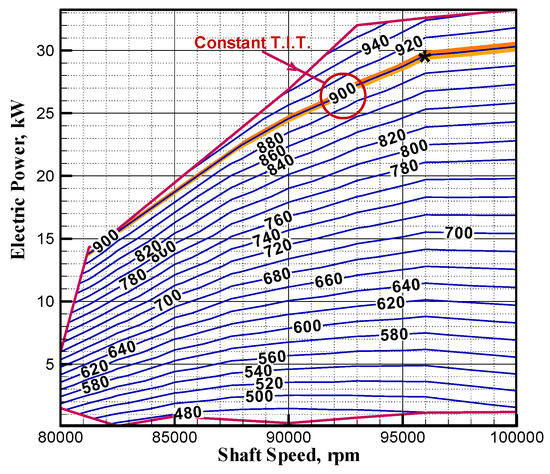
Figure 6.
Isolines of turbine inlet temperature (°C).
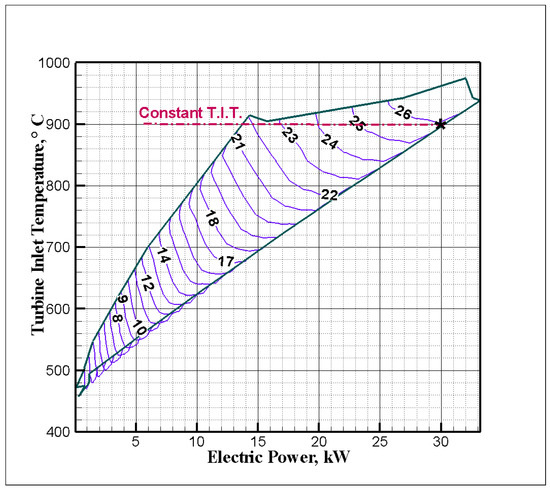
Figure 7.
Efficiency contours (%) in the MGT operating domain.
The above feature offers more interesting chances when considering the solar-integrated power plant: also in this case, the variable speed-constant T.I.T. regulation allows control of both electric and thermal output in a wide range (Figure 8), i.e., from full load to less than 50% load. The reduction in shaft speed involves decreases in both air mass flow rate and compressor pressure ratio (Figure 9) and, accordingly, the thermal cycle undergoes the variations already depicted in Figure 3. In particular, at lower loads the air temperature at the solar tower outlet increases due to the concurrent effects of a higher temperature at the recuperator exit and a greater temperature raise through the solar tower, because of the lower air flow rate with the same solar irradiance (Figure 10). Consequently, a much lower contribution is required to the fuel energy rate, with respect to the solar one, in order to reach the assigned T.I.T. level (Figure 11). This results in a relevant reduction of the fuel consumption when operating the MGT based plant in hybrid mode, with respect to the typical increase in fuel heat rate that can be observed in fuel only mode (Figure 12). The same Figure 12 indicates that the fuel utilization factor (FEUF) for combined heat and power production, which remains practically unchanged in fuel mode, undergoes significant increase at part-load for hybrid mode, solar assisted, operation.
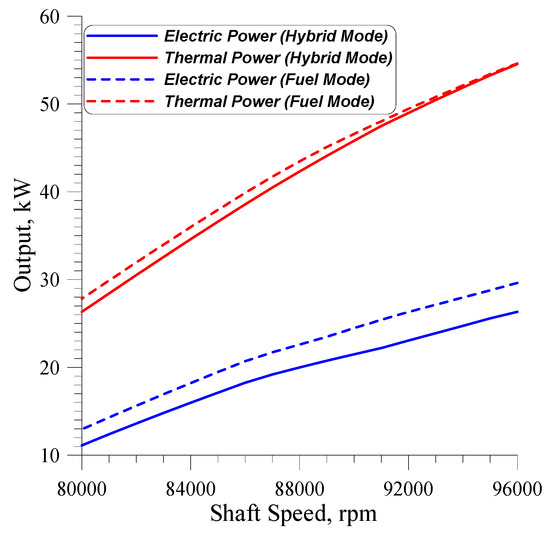
Figure 8.
Electric and thermal power with hybrid and fuel modes.
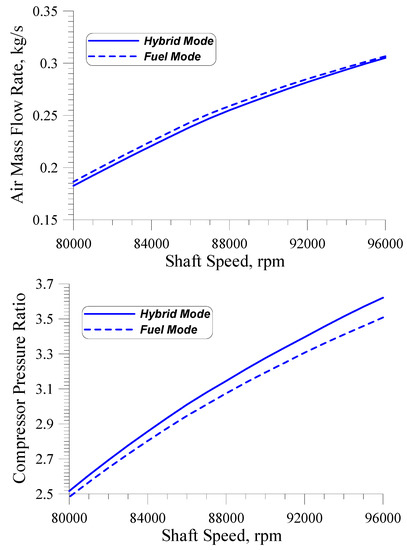
Figure 9.
Compressor operation parameters under hybrid and fuel mode conditions.
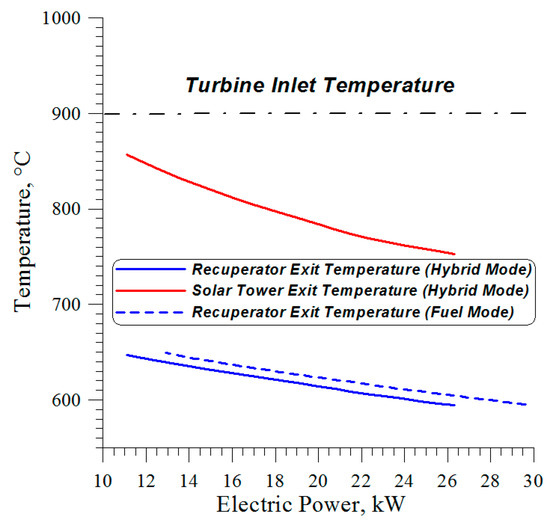
Figure 10.
Operating air temperatures at the MGT recuperator and solar tower exit.
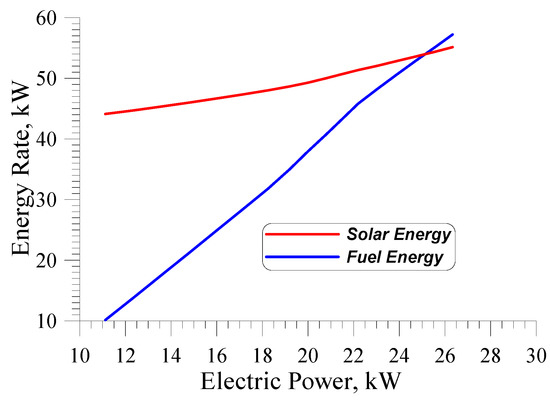
Figure 11.
Primary energy rates supplied to the solar-assisted micro gas turbine.
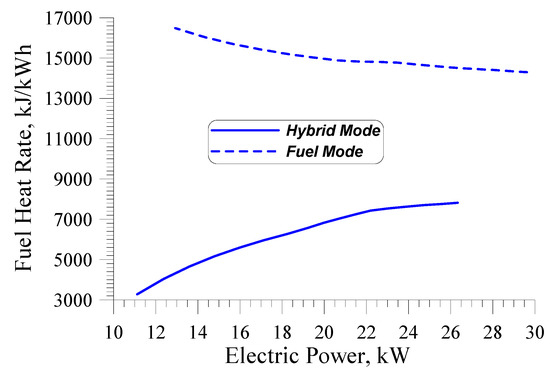
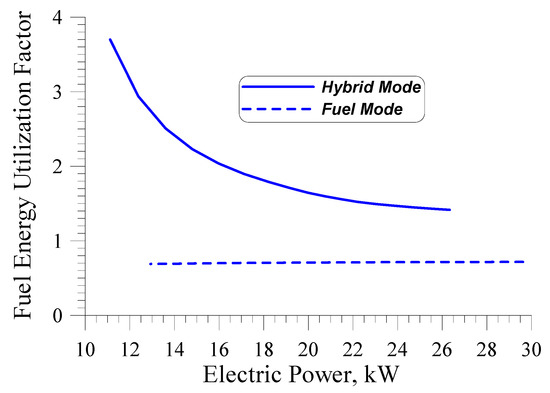
Figure 12.
Fuel consumption and utilization factor comparison in hybrid and fuel mode.
4. CFD Study of the Combustion
4.1. Combustor Design and Meshing
The combustor of C30 gas turbine is a reverse flow annular combustor. Starting from the combustor geometry sketches that are available in literature [27,28,29], a CAD design (Figure 13) has been realized in the mechanical modelling phase. The geometry created differs slightly from the real one due to the lack of official data from the manufacturer. In particular, the first row was added, to the aim of analyzing the combustion process by varying oxidant intake distribution throughout the primary zone. The combustor dimensions were chosen arbitrarily according to the most likely ones, if basing on the size of the whole C30 generator set.

Figure 13.
Combustor cross section and dimensions and outer and inner secondary holes (1, 4), dilution holes (2) and cooling holes (3).
Due to the periodicity of the combustor geometry, it was possible to carry out the study only on a third of the domain (i.e., a 120° sector) to reduce computational effort. The solid geometry was transferred to ANSYS Workbench (Figure 14) to be properly set before proceeding with the fluid-dynamic computations. In Figure 15 the injector model is shown. The swirl effect is ensured by deviating the slots from radial direction. Finally, the Figure 16 shows the mesh used for computations after a sensitivity analysis carried out by varying its resolution. In the same figure, the mesh size is also displayed.
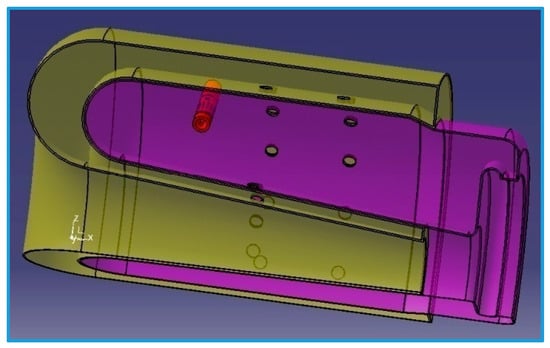
Figure 14.
View of the 120°, 3D sector of the combustor.
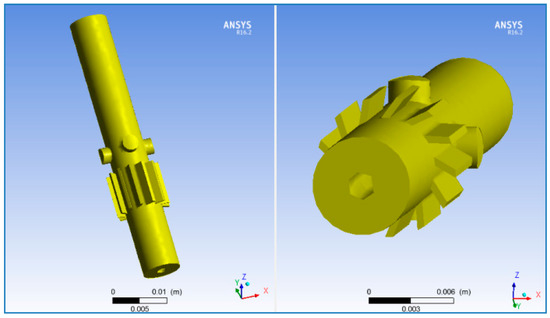
Figure 15.
Injector geometry.
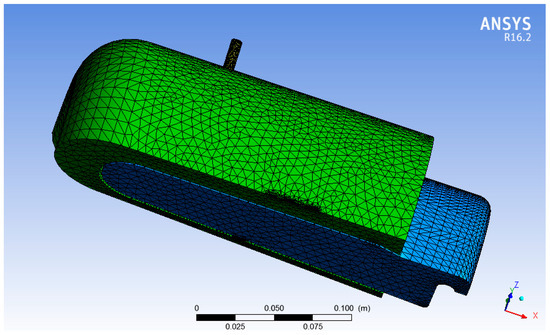
Figure 16.
Details of the computational mesh.
In this work, the 3D mesh was adopted only for a first assessment of the computational set-up. The simulation of the several cases were then carried out within a two-dimensional approximation of the domain with a mesh of 23,000 quadrilateral elements (Figure 17), after a mesh sensitivity analysis with grids of 6000, 23,000 and 90,000 cells.
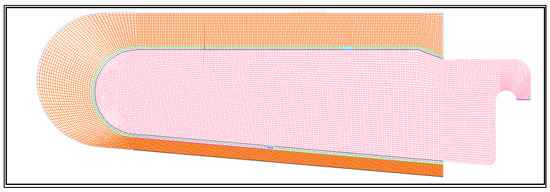
Figure 17.
Mesh of the 2D domain.
4.2. Computational Analysis and Results
The CFD analysis was performed with the ANSYS-FLUENT solver of the reacting flow by introducing for each case the related boundary conditions provided by the thermal cycle analysis, like reported in Table 5. This first set of computational cases refers to the same base rating conditions discussed in the previous section:

Table 5.
Boundary condition data for the combustion simulation (base rating).
The combustion development is modelled by a typical finite rate-eddy dissipation scheme that founds on a chemical kinetics set for the oxidation of the several species constituting the fuel (only the CH4 and C3H8 oxidation proceeds through two steps, i.e., partial and CO oxidation), according to Equation (1). The related reaction rates are compared with those evaluated by the turbulent mixing of the reactants, the latter estimated by a k-ε model. The nitric oxide prediction includes the computation of both thermal and prompt NO, according to the standard models implemented in the FLUENT® flow solver.
The choice of the k-ε model is also supported by the complexity of the flow field inside the reverse flow combustor: actually, besides the presence of zones involved in mixing flows, large vortexed regions can be detected, especially in the secondary and dilution zone of the combustor core (Figure 18), so that the primary combustion region can be easily identified.
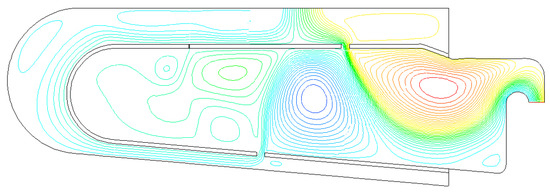
Figure 18.
Streamline pattern throughout the combustor.
The computations also include the coupled heat transfer from the core to external liner through the intermediate wall, for a better evaluation of the temperature gradients within the primary region.
The data in Table 5 highlight that the combustion takes place under conditions characterized by a very low overall fuel/air equivalence ratio, the fuel reduction in the solar-assisted cases emphasizes, of course, such conditions. Nevertheless, the flow distribution inside the combustor core allows a region with considerable equivalence ratios to be created (Figure 19). Due to the interaction with the air flows from the secondary and dilution holes, the combustor behaviour approximates the one of a RQL chamber [30].
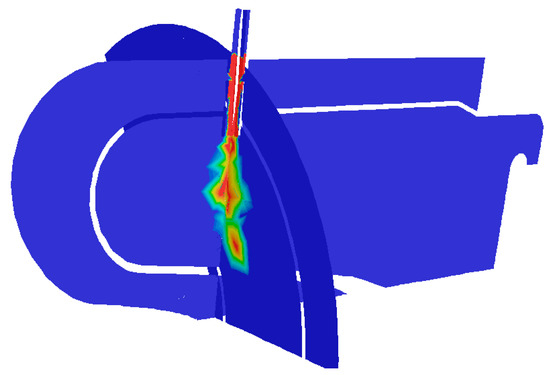
Figure 19.
Fuel/Air equivalence ratio in a meridional and a cross section (green = stoichiometric; yellow-red = rich).
The reactant distribution in the primary zones allows therefore an efficient ignition and combustion development. The sudden mixing with the secondary and dilution air should then preserve the process from an excess in nitric oxide formation. On the other hand, the existence of rich regions with poor oxygen contents could induce dissociation of carbon dioxide or slower oxidation of the carbon monoxide.
Figure 20 provides a comparison of the different temperature distributions that take place under standard and solar-assisted operating conditions. In the latter cases, the different fuel/air equivalence ratio produces an axial shift of the temperature peaks and, as expected, the biogas fuelling induces a lower average temperature level throughout the combustor.
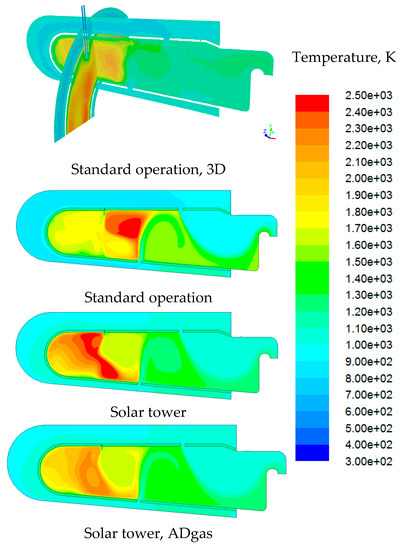
Figure 20.
Temperature distributions in the combustor.
The nitric oxide distributions in Figure 21 are strictly related, as it is self-evident, to the above discussed temperature profiles. The noticeable reduction in this pollutant when adopting the ADgas is clearly evidenced.

Figure 21.
Nitric oxide mass fraction distributions inside the combustor.
The above predictions are substantially confirmed by the summarizing results in Table 6. First, the comparison of the 3D and 2D simulations indicate that the latter is able to provide an acceptable approximation of the more accurate analysis. Actually, the temperature distributions in meridional sections of the 3D domain appear to be fairly reproduced by the two-dimensional profiles. In both cases, the separation between the high temperature region and the secondary zone can be clearly detected (Figure 20).

Table 6.
Combustor core and outlet properties from CFD based simulations.
The combustion development in the cases related to the solar tower introduction appear to be satisfactory in terms of practical absence of unburned species. Despite of the inlet air temperature increase, the level of nitric oxides is not raised and it is strongly reduced by the adoption of the biogas thanks to the lower flame temperatures, like stated in the same Table 5.
5. Off-Design Operation of the Integrated Power Plant
5.1. Variable Load or Ambient Conditions
In this section, the effect of variations in either power output or environmental conditions is discussed. As previously stated, the reference conditions, for both external air parameters and solar irradiance were set at the vernal equinox. Therefore, relevant changes are of course expected at two typical opposite dates, like the summer and winter solstices. It should be reminded that, once established the extent of the mirror array, changes in solar irradiance produce relevant alteration in the air temperature at the combustor inlet. A direct effect is, obviously, expected on the fuel energy saving but the correctness of the combustion development should also be checked. A similar effect can be induced by part-load operation: like anticipated, the integration with the solar power allows the micro turbine to be operated at reduced load by preserving the firing temperature (like already observed in Figure 3). This is also made possible by the variable speed electrical generator that produces a reduction in the mass flow rate of the working air. The result is an increase in the combustor entry temperature for the same total amount of solar irradiance. All the above considerations are substantially confirmed by the results of the thermal cycle analysis in Table 7.

Table 7.
Off-design performance data of the integrated MGT-CHP plant.
Actually, the load decrease and the irradiance increase, the latter in the warm season, produce quite similar effects in terms of specific heat rate reduction. A certain decrease is observed at part-load for the total energy utilization factor, while the same parameters attains higher values at the summer solstice. The much lower solar irradiance at winter solstice results in a greater request of fuel supply. Nevertheless, the solar contribution allows a moderate increase in the combustor inlet temperature and a quite satisfactory heat recovery, like demonstrated by the TEUF level.
5.2. CFD Analysis of the Combustion
Regarding the same cases that have been discussed above, a CFD based check of the combustion effectiveness and of the pollutant formation has been carried out. Actually, both the part load case and the summer solstice operation are characterized by a further reduction in the fuel/air ratio (Table 8), so that a weak combustion regime could occur. This could result in critical conditions for the combustion development and in an excess in unburned species. Conversely, the combustion chamber operation at the vernal equinox conditions has already demonstrated an effective behaviour, and a similar response is expected from the winter solstice conditions.

Table 8.
Boundary conditions for the combustor off-design (Natural Gas (NG) fuelling, numbers in brackets refer to ADgas fuelling).
The summarizing results of the CFD simulations in Table 9, confirm that the “weak regime” combustions are characterized by a lack in fuel oxidation efficiency (burned fuel/total fuel) while more satisfactory levels are reached by the high loaded cases. The nitric oxide level appears to be controlled in each case, while a relevant production in carbon monoxide is exhibited by the winter solstice case, due to the additional fuel supply requirement.

Table 9.
Off-design performance of the MGT combustor (NG fuelling, numbers in brackets refer to ADgas fuelling).
The temperature distributions are displayed in Figure 22 and Figure 23 for the strong and weak combustion regime, respectively. The first cases are characterized by the typical temperature profiles in the primary and secondary and dilution regions, like discussed in the previous section.
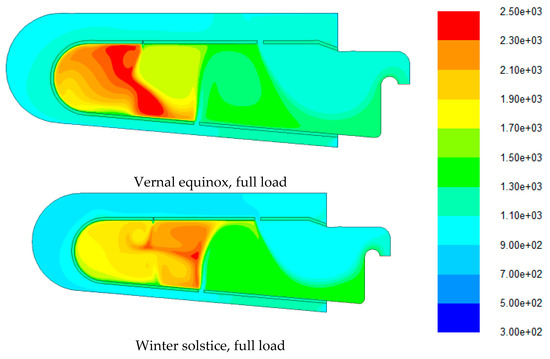
Figure 22.
Temperature distributions (K) in the MGT combustor (natural gas fuelling, high load).
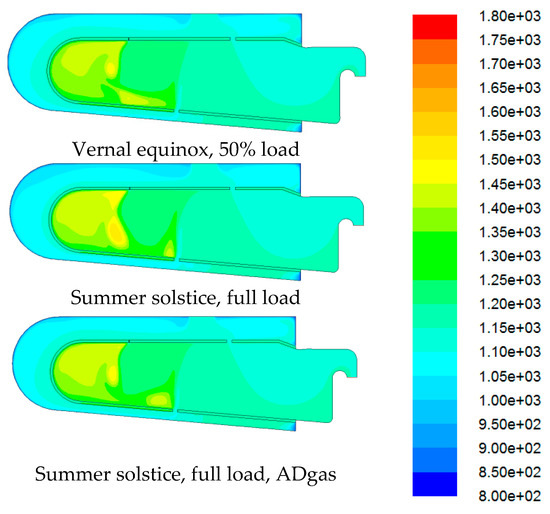
Figure 23.
Temperature distributions (K) in the MGT combustor (weak regime).
The weak regime causes, on the contrary, a limited temperature rise in the primary zone of the combustor core, which is related to the fuel poor oxidation rate. Such a condition should therefore be identified as a critical one. The defeat in combustion activity could be probably overcome by the adoption of a pilot fuel injection in lieu of the premixed one, even if this solution could lead to increases in thermal and prompt nitric oxides.
6. Conclusions
In the first part of this paper, the authors have compared two particular layouts for a power plant based on the integration of a micro gas turbine with a concentrated solar array. The first scheme includes an additional contribution to the power output from the ORC system while preserving acceptable performance in CHP mode. The second concept considers a thermal energy contribution from a solar tower and it appears to be much more effective in terms of energy saving, including the part-load conditions.
On the other hand, the latter layout is characterized by relevant changes in the combustor operation, in terms of both air entry temperature and fuel/air equivalence ratio. This convinced the authors to perform a CFD analysis of the combustion development, after the set-up of the geometrical domain and the computational grids. The related results have highlighted a fairly satisfactory response of the combustor at full load and when nominal or reduced solar irradiance occurs. More critical conditions have been evidenced at part-load operation or with an excess of temperature raise at the combustor inlet, like in the warm seasons, because of the low fuel/air equivalence ratio. The CFD activities have also confirmed that the adoption of a low LHV fuel, like a biogas from anaerobic digestion, produces a combustor response rather similar to the one occurring for natural gas fuelling. The nitric oxide emission appears to be controlled, while more challenging problems are related with the CO formation.
The authors’ future work, besides expanding the numerical approach for optimizing the integrated plant parameters, will be supported by experimental tests in the MGT Laboratory at the Center of Service for Advanced Measurements (Ce.S.M.A.) of the University of Naples, which is equipped with a Capstone C30 turbine.
Supplementary Files
Supplementary File 1Acknowledgments
The research is financed by POR Campania 2007–2013, Project RISE: Research, Innovation and Development in the Energy sector (CUP: B95C12001070007). The plant simulations are performed by the THERMOFLEX software, licensed from Thermoflow Inc. The CFD computations are licensed by ANSYS-FLUENT.
Author Contributions
Carmelina Abagnale dealt with the CAD design of the combustion chamber for the subsequent mesh generation; Maria Cristina Cameretti was involved in the set up of the thermodynamic analysis and of the CFD procedure and analyzed the related data; Roberta De Robbio worked at the mesh generation of the combustor and at the definition of the combustion and pollutant mechanisms. She also performed the numerical experiments; Raffaele Tuccillo supervised and wrote the article and analyzed the results together with the co-authors.
Conflicts of Interest
The authors declare no conflict of interest.
Nomenclature
| AD | Anaerobic digestion |
| CHP | Combined heat and power |
| CSP | Concentrated solar power |
| Mass flow rate | |
| (m) | Molecular mass |
| MGT | Micro gas turbine |
| N | Rotational speed (rpm) |
| NG | Natural gas |
| p | Pressure |
| P | Power |
| R | Reaction rate |
| T | Temperature |
| TEUF | Total energy utilization factor |
| T.I.T. | Turbine inlet temperature |
| 1 | Compressor inlet |
| 2 | Compressor outlet |
| 2r | Recuperator outlet (cold side) |
| 2s | Solar Array outlet |
| 3 | Combustor outlet |
| 4 | Turbine outlet |
| 4r | Recuperator outlet (hot side) |
References
- Aichmayer, L.; Spelling, J.; Laumert, B. Preliminary design and analysis of a novel solar receiver for a micro gas-turbine based solar dish system. Sol. Energy 2015, 114, 378–396. [Google Scholar] [CrossRef]
- Lanchi, M.; Montecchi, M.; Crescenzi, T.; Mele, D.; Miliozzi, A.; Russo, V.; Mazzei, D.; Misceo, M.; Falchetta, M.; Mancini, R. Investigation into the coupling of micro gas turbines with CSP technology: OMSoP project. Energy Procedia 2015, 69, 1317–1326. [Google Scholar] [CrossRef]
- Spelling, J.; Aichmayer, L.; Laumert, B. Thermoeconomic evaluation of a novel utility-scale hybrid solar dish micro gas-turbine power plant. In Proceedings of the ASME Turbo Expo 2015: Turbine Technical Conference and Exposition, Montreal, QC, Canada, 15–19 June 2015. [Google Scholar]
- Felsmann, C.; Gampe, U.; Freimark, M. Dynamic behavior of a solar hybrid gas turbine system. In Proceedings of the ASME Turbo Expo 2015: Turbine Technical Conference and Exposition, Montreal, QC, Canada, 15–19 June 2015. [Google Scholar]
- Camporeale, S.M.; Ciliberti, P.D.; Fortunato, B.; Torresi, M.; Pantaleo, A.M. Externally fired micro gas turbine and ORC bottoming cycle: optimal biomass/natural gas CHP configuration for residential energy demand. In Proceedings of the ASME Turbo Expo 2015: Turbine Technical Conference and Exposition, Montreal, QC, Canada, 15–19 June 2015. [Google Scholar]
- Quoilin, S.; Orosz, M.; Hemond, H.; Lemort, V. Performance and design optimization of a low-cost solar organic Rankine cycle for remote power generation. Solar Energy 2011, 85, 955–966. [Google Scholar] [CrossRef]
- Melino, F.; Peretto, A.; Bianchi, M.; De Pascale, A.; Branchini, L. Investigations on a Test Bench for Integrated ORC-FC Micro-CHP Energy Systems. In Proceedings of the ASME Turbo Expo 2014: Turbine Technical Conference and Exposition, Düsseldorf, Germany, 16–20 June 2014. [Google Scholar]
- Demierre, J.; Rubino, A.; Schiffmann, J. Modeling and Experimental Investigation of an Oil-Free Micro Compressor-Turbine Unit for an ORC Driven Heat Pump. In Proceedings of the ASME Turbo Expo 2014: Turbine Technical Conference and Exposition, Düsseldorf, Germany, 16–20 June 2014. [Google Scholar]
- Olivenza-León, D.; Medina, A.; Calvo Hernández, A. Thermodynamic modeling of a hybrid solar gas-turbine power plant. Energy Convers. Manag. 2015, 93, 435–447. [Google Scholar] [CrossRef]
- Cioffi, M.; Pontecorvo, A.; Tuccillo, R. Employing micro-turbine components in low-range organic Rankine cycle power plants. In Proceedings of the ASME-ATI-UIT 2010 Conference Thermal and Environmental Issues in Energy Systems, Sorrento, Italy, 16–19 May 2010; pp. 165–170. [Google Scholar]
- Dumont, O.; Quoilin, S.; Lemort, V. Design Modeling and Experimentation of a Reversible HP-ORC Prototype. In Proceedings of the ASME Turbo Expo 2014: Turbine Technical Conference and Exposition, Düsseldorf, Germany, 16–20 June 2014. [Google Scholar]
- Zhang, L.; Zhuge, W.; Peng, J.; Zhang, Y. The Influence of Real Gas Thermodynamics on ICE-ORC Turbine Flow Fields. In Proceedings of the ASME Turbo Expo 2014: Turbine Technical Conference and Exposition, Düsseldorf, Germany, 16–20 June 2014. [Google Scholar]
- Semprini, S.; Sànchez, D.; De Pascale, A. Performance analysis of a micro gas turbine and solar dish integrated system under different solar-only and hybrid operating conditions. Sol. Energy 2016, 132, 279–293. [Google Scholar] [CrossRef]
- Sánchez, D.; Bortkiewicz, A.; Rodríguez, J.M.; Martínez, G.; Gavagnin, G.; Sánchez, T. A methodology to identify potential markets for small-scale solar thermal power generators. Appl. Energy 2016, 169, 287–300. [Google Scholar] [CrossRef]
- Zare, V.; Hasanzadeh, M. Energy and energy analysis of a closed Brayton cycle-based combined cycle for solar power tower plants. Energy Convers. Manag. 2016, 128, 227–237. [Google Scholar] [CrossRef]
- Grange, B.; Dalet, C.; Falcoz, Q. Impact of thermal energy storage integration on the performance of a hybrid solar gas-turbine power plant. Appl. Therm. Eng. 2016, 105, 266–275. [Google Scholar] [CrossRef]
- Santos, M.J.; Merchan, R.P.; Medina, A.; Hernández, A.C. Seasonal thermodynamic prediction of the performance of a hybrid solargas-turbine power plant. Energy Convers. Manag. 2016, 115, 89–102. [Google Scholar] [CrossRef]
- Pozivil, P.; Ettlin, N.; Stucker, F.; Steinfeld, A. Modular design and experimental testing of a 50 kWth pressurized-air solar receiver for gas turbines. J. Sol. Energy Eng. 2015, 137, 031002. [Google Scholar] [CrossRef]
- Cameretti, M.C.; Ferrara, F.; Gimelli, A.; Tuccillo, R. Combined MGT-ORC solar-hybrid system. Part A: Plant optimization. Energy Procedia 2015, 81, 368–378. [Google Scholar] [CrossRef]
- Cameretti, M.C.; Ferrara, F.; Gimelli, A.; Tuccillo, R. Combined MGT-ORC solar-hybrid system. Part B: Component analysis and prime mover selection. Energy Procedia 2015, 81, 379–389. [Google Scholar] [CrossRef][Green Version]
- Cameretti, M.C.; Ferrara, F.; Gimelli, A.; Tuccillo, R. Employing Micro-Turbine Components in Integrated Solar–MGT–ORC power plants. In Proceedings of the ASME Turbo Expo 2015: Turbine Technical Conference and Exposition, Montreal, QC, Canada, 15–19 June 2015. [Google Scholar]
- Cameretti, M.C.; Langella, G.; Sabino, S.; Tuccillo, R. Modeling of a hybrid solar micro gas-turbine power plant. Energy Procedia 2015, 62, 833–840. [Google Scholar] [CrossRef]
- Abagnale, C.; Cameretti, M.C.; De Robbio, R.; Tuccillo, R. CFD study of a micro-combustor supplied with syngas. Energy Procedia 2016, 101, 933–940. [Google Scholar] [CrossRef]
- Bakalis, D.P.; Stamatis, A.G. Full and part load exergetic analysis of a hybrid micro gas turbine fuel cell system based on existing components. Energy Convers. Manag. 2012, 64, 213–221. [Google Scholar] [CrossRef]
- Cameretti, M.C.; Tuccillo, R.; Piazzesi, R. Study of an exhaust gas recirculation equipped micro gas turbine supplied with bio-fuels. Appl. Therm. Eng. 2013, 59, 162–173. [Google Scholar] [CrossRef]
- Cameretti, M.C.; Tuccillo, R. Combustion features of a bio-fuelled micro-gas turbine. Appl. Therm. Eng. 2015, 89, 280–290. [Google Scholar] [CrossRef]
- Chen, J.; Mitchell, M.G.; Nourse, J.G. Development of Ultra-Low Emission Diesel Fuel-Fired Microturbine Engines for Vehicular Heavy Duty Applications: Combustion Modifications. In Proceedings of the ASME Turbo Expo 2010: Power for Land, Sea, and Air, Glasgow, UK, 14–18 June 2010. [Google Scholar]
- Phi, V.M.; Mauzey, J.L.; McDonell, V.G.; Samuelsen, G.S. Fuel Injection and Emissions Characteristics of a Commercial Microturbine Generator. In Proceedings of the ASME Turbo Expo 2004: Power for Land, Sea, and Air, Vienna, Austria, 14–17 June 2004. [Google Scholar]
- Colorado, A.; McDonell, V.G. Reactor Network Analysis to Assess Fuel Composition Effects on NOx Emissions from a Recuperated Gas Turbine. In Proceedings of the ASME Turbo Expo 2014: Turbine Technical Conference and Exposition, Düsseldorf, Germany, 16–20 June 2014. [Google Scholar]
- Laranci, P.; Bidini, G.; D’Alessandro, B.; Zampilli, M.; Forcella, F.; Fantozzi, F. Improving Lifetime and Manufacturability of an RQL Combustor for Microturbines: Design and Numerical Validation. In Proceedings of the ASME Turbo Expo 2015: Turbine Technical Conference and Exposition, Montreal, QC, Canada, 15–19 June 2015. [Google Scholar]
© 2017 by the authors. Licensee MDPI, Basel, Switzerland. This article is an open access article distributed under the terms and conditions of the Creative Commons Attribution (CC BY) license (http://creativecommons.org/licenses/by/4.0/).